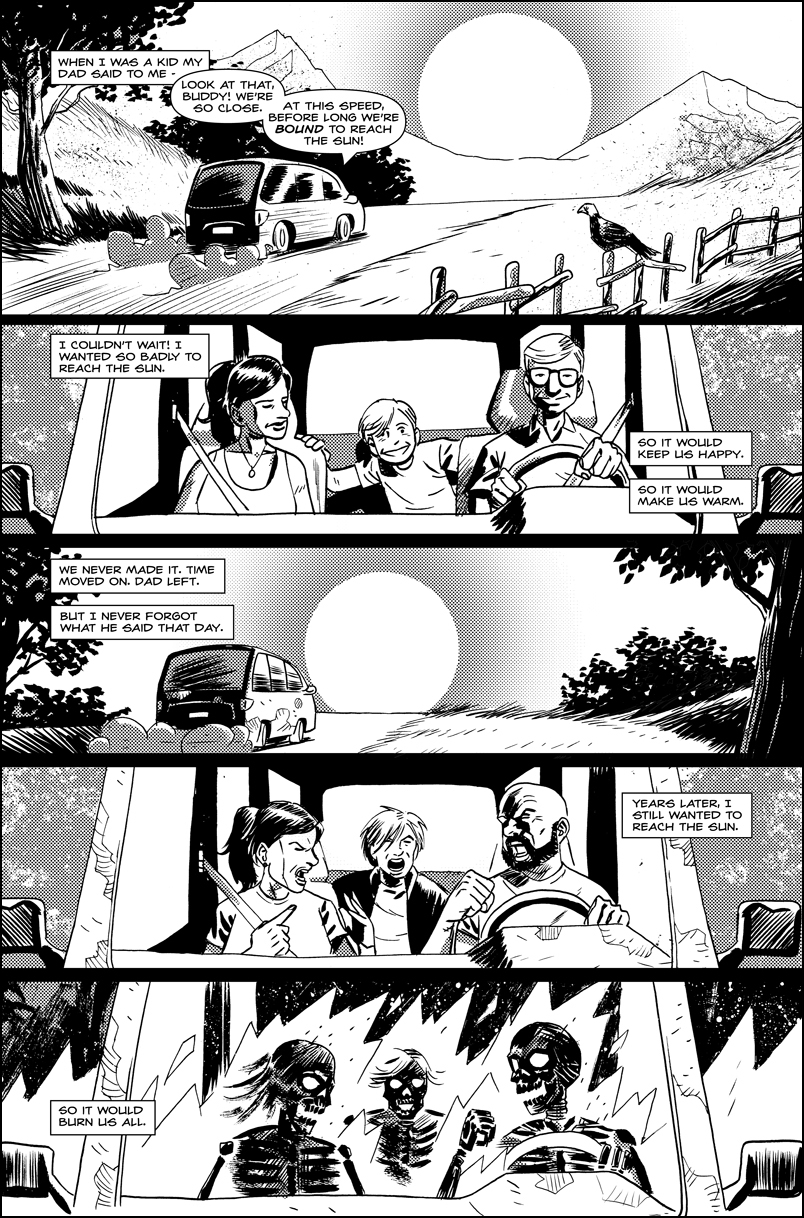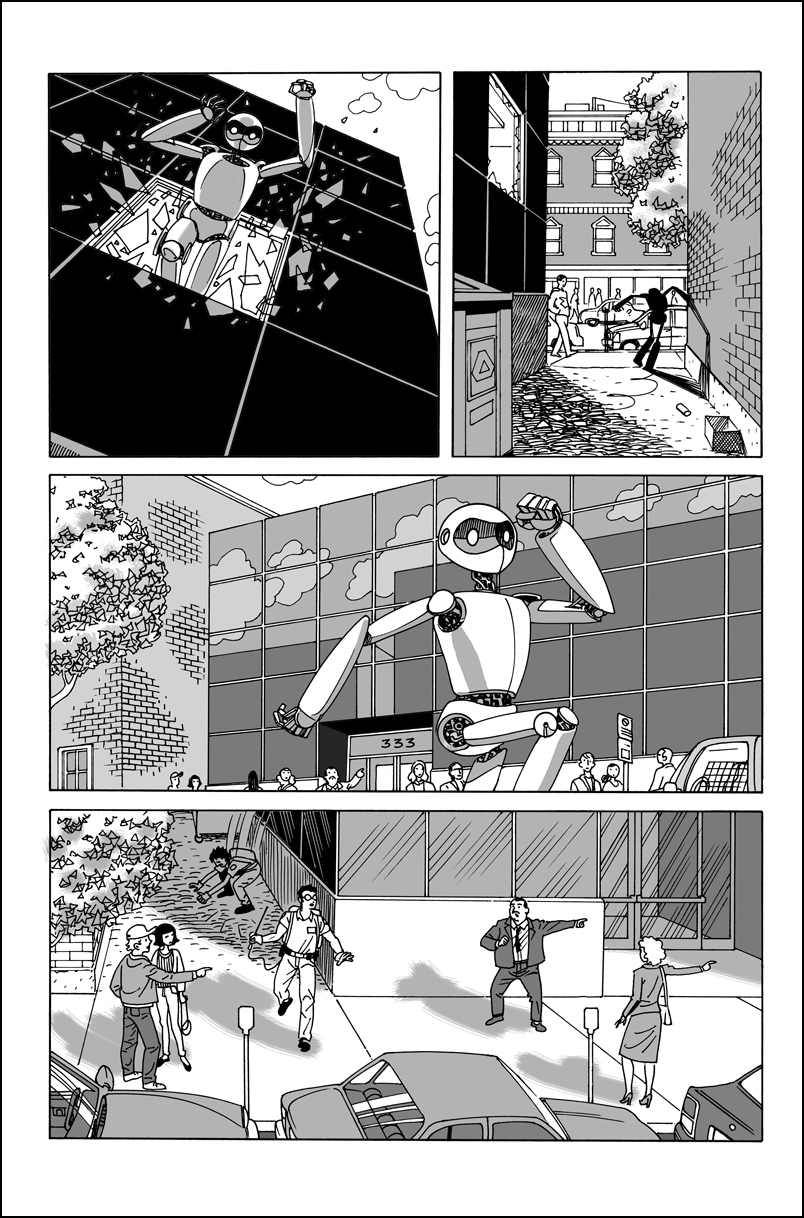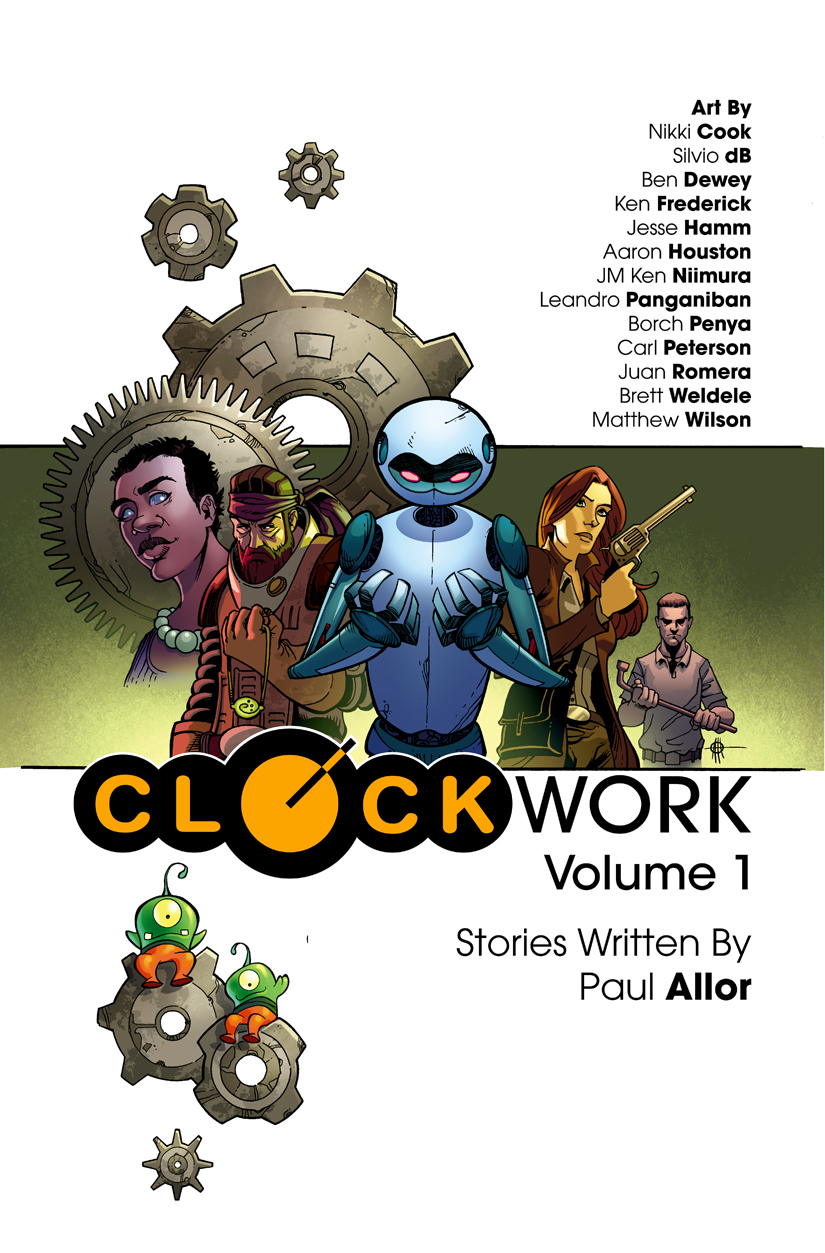Review: Clockwork, Volume 1
Clockwork is a tricky anthology to sell. There is no succinct elevator pitch you can give to let potential readers know what to expect from the book. The 12 stories contained within are not linked by any common genre, or even a common theme. At most, you might argue there is something of a consistent tone running through all the stories, an introspective, character-driven quality that they all share. But the one unifying element in all these stories is that they are written by newcomer Paul Allor, presenting here what he says is a collection of his first work in the comics medium. So, if anything, the elevator pitch is a collection of short stories by Paul Allor, and that’s a risky position for any writer to take, never mind a new one. You’re putting yourself front and centre, instead of the genre. And as a result, the success or failure of your book rests largely on your shoulders, and could be taken as a judgement of you personally. To be able to shoulder that burden, as a writer you must have a distinctive, compelling enough voice to justify that scrutiny. Does Clockworks pull off that tricky balancing act?
Thankfully, I can report that this first volume of Clockwork is a huge success. While every anthology has some stories that are better than others, and having at least one weak link in the collection almost comes with the territory of the format, there’s not a single dud amongst these 12 shorts. Many of these stories could easily sustain a much longer narrative, with characters that feel lived-in and fully realised despite us only having a handful of pages to get to know them. It helps, of course, that Allor has chosen an array of highly talented artists to work alongside, each of them bringing their own flavor to the respective collaborations.
The first story, Another Life , takes us across numerous planets and the span of a lifetime in the span of 5 pages, without feeling crammed. That’s because, in spite of the epic, space-faring scope of this story, everything revolves around a simple character arc, condensed into one particular emotional beat that says more about notorious space-pirate The Butcher than pages of exposition could hope to. Artist Ben Dewey plays a big role in making the world of Another Life tangible and nuanced without too much script space needing to be devoted to explaining it. He populates this world with space monasteries, futuristic architecture and a variety of alien species and human-animal hybrids that very quickly create the sense that this is a thriving universe with a whole variety of narrative possibilities contained within it. This level of creative ambition, coupled with the bittersweet ending, sets the tone perfectly for all the stories that follow, making it the ideal choice to start the collection.
The diversity of Clockwork is quickly demonstrated in the choice of the second story, The Hottest Part of Winer . With this tale, we jump from the far reaches of the distant future and outer space to the familiar past of the Old West. One element of this book I really enjoyed is the one-page prose introductions to each story by Allor, filled with interesting insight into the comic that will follow. In this case, he brings up a great point, that Westerns are inherently about change. In this case, the change is a very personal one, based on a decision made by our main character. The more cartoonish art of Carl Peterson works well here, nicely complimenting the more optimistic tone of this piece.
From the future, to the past, to the present, with some slice-of-life human drama in the form of Reach the Sun . This was one of my favourites in the collection, with Allor crafting a story that’s simple, but has such powerful emotional resonance, chronicling the struggles of a troubled teenager to recapture the happiness of his earlier childhood. A big part of what makes this story work so well is the artwork of Juan Romera, who I must admit I’m becoming a real fan of. He was a standout in the Tall Tales from the Badlands Western anthology, where he first caught my attention, and I’ve talked at length about how impressed I was by his work on Fabian Rangel Jr’s Fall for 215 Ink. Here, Romera continues to demonstrate his incredible talent for framing panels and capturing facial expressions and body language in a way that really maximising the emotion of the scene, while showing perhaps greater detail and intricacy than in his other, more stylised work, suggesting he continues to grow and evolve. He is definitely an artist to watch.
The Things I See is perhaps a little on-the-nose with its dialogue in places, which is a departure from the deft subtlety with words Allor displays in most of Clockwork. But the concept of a blind and deaf woman with psychic powers is a good one, and even as one of the weaker instalments in this collection, there’s still a lot to like here. Of particular note are the meticulously crafted visuals of Nikki Cook, whose heavy inks give this tale a fluid, almost dreamlike quality.
I was really charmed by Cage Around My Heart , a story about a robot called BART who escapes from his creators, hoping to share in human experiences such as love. It’s a touching story, and a little sad, but its impact utterly depends on how much you buy into BART as a figure to care about. And we do, thanks to how Jesse Hamm brings him to life. He has a blank, unchanging robotic face with unmoving eyes and no mouth, and so is incapable of expressing emotion. So, how then do we see joy, hope, hurt and despair in that face? It’s all down to how Hamm angles and frames BART, and it’s a credit to his skill that we believe in this robot’s humanity.
In his introduction to The Day I Go Home , Allor mentions that it was the first of the scripts he wrote for Clockwork, his first published work. As such, it’s interesting to see how much of the whole anthology is reflected in this original sci-fi piece. It has that ambiguous, bittersweet quality to it shared by many of its peers, as well as being intensely character-driven. I think the art of Leandro Panganiban lets it down slightly. While his figure work is strong and his scenery is detailed, the lack of textures or grayscaling in the piece leaves the whole story looking quite flat, which is a shame.
With The End of This Story , Allor branched out into yet another genre, this time fantasy. The story, recounting the millennia-spanning war between humans and monsters, is pretty simple and straightforward, but with a poignant wrinkle at the end that makes the story an effective sister piece to the preceding The Day I Go Home . Silvio dB’s art is pretty cool, channelling a real old school Prince Valiant vibe. I would venture to say the inks are a little heavy, as in places it muddies the detail of the panels, but that’s a minor gripe.
Skull Buzz is one of the most cleverly-structured of Allor’s tales. Without giving too much away, it opens seeming very much like one story about a man’s personal struggle, but takes a surprising turn into something quite different. As was the case with Panganiban’s work on The Day I Go Home , the art of Ken Frederick is lacking in any grayscale or texture. But rather than being to its detriment, in this particular story this sketchiness is a strength, generating an abstract, distant quality that fits well with how the narrative develops.
While I admire the ambiguous elements in other stories, Mercy Kill is a little too oblique for my tastes. I get the ideas Allor is playing with here, but I think the story could have used just a little more meat on the bones, a little more detail on the main character’s experiences, to encourage us to invest in her situation some more. But this is still a haunting little story, with Brett Weldele delivering the goods with some moody, stylised art and evocative use of grayscale.
Plutoville is, according to the introduction, Allor’s ode to monsters in space films such as Alien, albeit with a twist that, though I saw it coming early on, is nevertheless well executed. The fact that there are several sci-fi shorts in Clockwork, but each one is radically different, is a testament to the diversity of both the sci-fi genre and Allor himself. The crisp, kinetic layouts of Borch Penya give Plutoville a real sense of energy and dynamism.
When I saw the name of artist JM Ken Niimura attached to Warlord , I must admit my heart skipped a beat. Getting to work with the co-creator of modern comics classic I Kill Giants is a big deal indeed. And while Niimura’s work here doesn’t quite match some of his jawdropping visuals in I Kill Giants, that fine grasp of pacing and emotion remains very evident. Another one of Allor’s more oblique tales, Warlord gives us five different vignettes, showing how various individuals in a feudal landscape have had their lives shaped (and in some cases ruined) by a faceless warlord, before finally showing us the warlord himself. The very nature of the story – essentially 5 one-pagers – makes it hard to be truly attached to any one individuals plight, but the cumulative effect of their stories gives the finish real kick. And it’s drawn by JM Ken Niimura!
Finally, we have X-Row , which is perhaps Allor’s most narratively ambitious work in the anthology. It tells the story of a man on death row flashing through various memories of his life as he prepares for death. As a result, the story is constructed largely as a series of one-panel vignettes, without much linear narrative, but Allor still manages to create a full picture of his main character through this collection of memories, and we are able to piece together a full arc of a life lived and a journey taken from them. Excellent writing. The art of Aaron Houston (who is also responsible for the stylish cover) is great too, with his detailed linework and mastery of scene-setting turning each panel into a fully-realised snapshot of a moment in time. And being able to show our protagonist at various stages in his life and have him go through a wide range of ages (and haircuts) while still being immediately recognisable as the same person is quite a skill. With X-Row , Clockwork certainly ends on a high note.
Not that there’s any significant low note. I got my hands on this book several weeks ago, and it took me until last night to finally get around to reading it. But once I started, I breezed through it, engrossed in the contents from beginning to end. There are a couple of minor issues here and there – Allor can keep us at arm’s length a bit too much sometimes, with even something as small as none of his characters (apart from BART) having names acting as a distancing device – but the good far outweighs the bad. Allor shows an ability to work in a diverse range of genres, a mastery of pacing and structure, and a real knack for getting to the human core of a situation, even in what might at first seem like more plot-driven genre fare.
At the start of this review, I remarked on how big a gamble it was essentially marketing a book on your name. But in this case, the gamble worked. At the back of the volume there is an advert for Clockwork, Volume 2. Based on the strength of this first volume, I would happily buy it. And thanks to Clockwork, Volume 1, seeing the name Paul Allor on the cover of a comic would be enough to make me give it a try.
***
Artists: Nikki Cook, Silvio dB, Ben Dewey, Ken Frederick, Jesse Hamm, Aaron Houston, JM Ken Niimura, Leandro Panganiban, Borch Penya, Carl Peterson, Juan Romera, Brett Weldele
Letterer: Paul Allor, Ken Frederick, Brett Weldele, JM Ken Niimura
Cover Artist: Aaron Houston
Cover Colorist: Matthew Wilson
Cover Design: Paul Allor, Rich Douek
Cover Logo: E.T. Dollman
Publisher: Gov’t Comics
Price: $12.00
Synopsis: The twelve short comics in Clockwork, Vol. 1 defy genre lines, taking you on a journey from the Old West to outer space, from death row to a child’s home. Writer Paul Allor is joined by some of today’s most exciting artists, including JM Ken Niimura, Brett Weldele and Nikki Cook, in a book that combines dynamic storytelling and true heart.
Clockworks is available to buy from the official website of Gov’t Comics.
Related Posts:
Category: Comics, The Creator-Owned Zone





















Thanks, John. I really appreciate the kind words, and the fact that you discussed each of the awesome artists in this book!
Great review. I believe Paul is an outstanding writer and this is the first of many fine books.
Awesome, detailed review!
Thanks for the comments, guys! Between the 3 of you, I think this has become my most commented-on column ever for ComixTribe!
I really enjoyed this comic as well as the authors commentary. He had a very clear goal in what he was trying to accomplish with each story. For the most part i’d say he was successful.
Looking forward to a volume 2